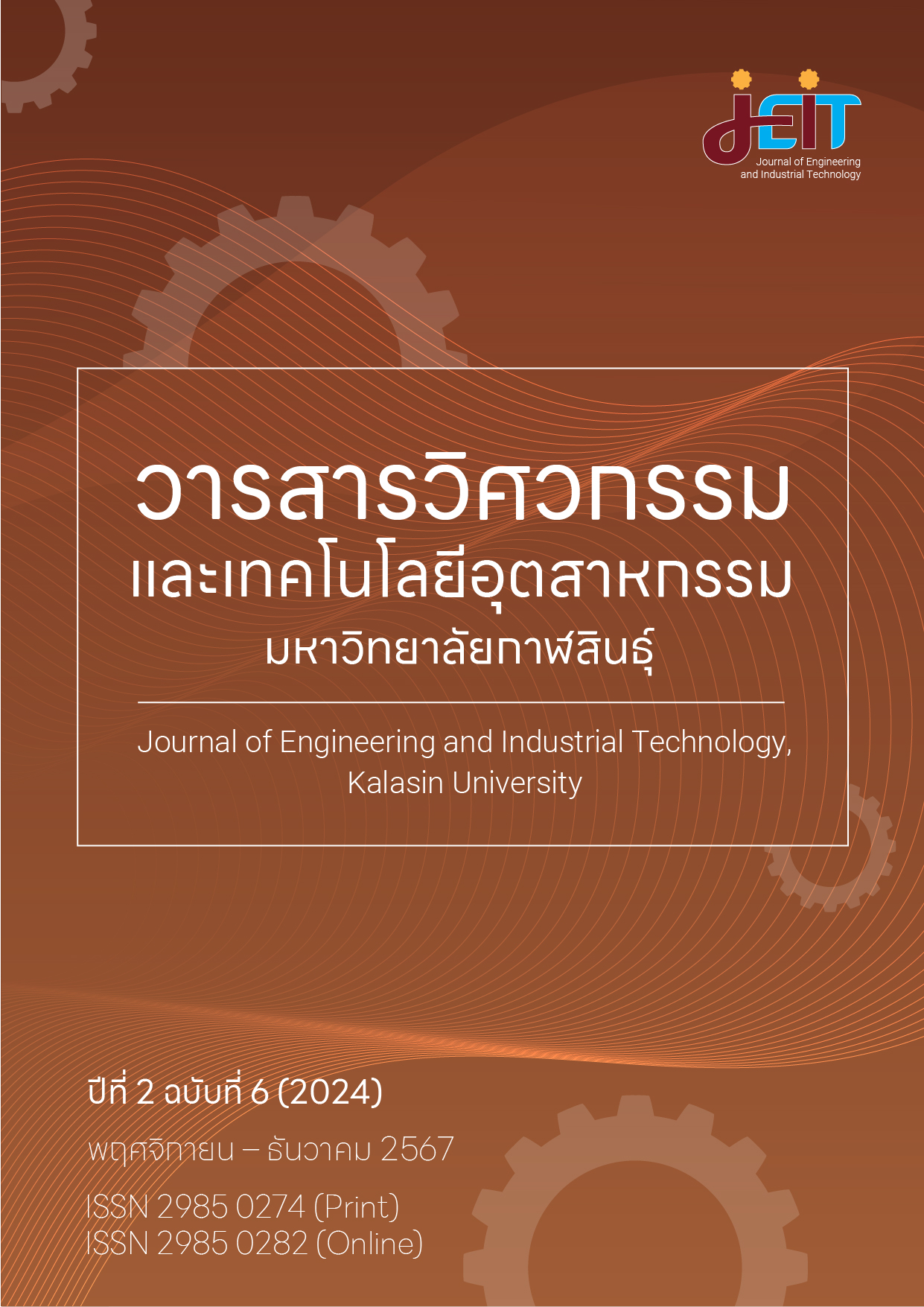Factors Affecting Anaerobic Biogas Digestion from Cassava Pulp and Wastewater
DOI:
https://doi.org/10.14456/jeit.2024.27Keywords:
Anaerobic digestion, Biogas, Cassava pulp, Wastewater, Optimal ratioAbstract
This study aims to investigate the factors affecting biogas production from cassava pulp and wastewater. Experiments were conducted using five ratios of cassava pulp to wastewater: 1:1, 2:1, 3:1, 1:2, and 1:3. ANOVA analysis revealed that the ratios significantly influenced biogas production, with the 1:3 ratio yielding the highest gas output of 8.81 liters on day 13. In comparison, the 1:2 ratio produced 6.17 liters, while the other ratios (1:1, 2:1, and 3:1) resulted in significantly lower outputs. Further experiments using an 80-liter fermenter at the 1:3 ratio examined stirring speeds of 45 and 110 rpm. The results showed that 110 rpm improved microorganism and nutrient distribution in the fermenter, reducing the accumulation of inhibitory substances such as fatty acids. This led to biogas production starting on day 5 and increasing steadily to a maximum of 45.14 liters on day 13. In contrast, the 45 rpm stirring speed began biogas production on day 7, with a peak output of only 21.58 liters. These findings confirm that the 1:3 ratio and a stirring speed of 110 rpm are optimal for biogas production from cassava pulp and wastewater. This research can be applied to enhance biogas production efficiency in industrial settings.
References
[1] A. M. P. Santos, A. L. S. Castro, K. R. Salonon, T. S. O. Souza, and D. Vich, "Global research trends on anaerobic digestion and biogas production from cassava wastewater: A bibliometric analysis," J. Chem. Technol. Biotechnol., vol. 96, no. 11, pp. 3035–3050, Nov. 2021, doi: 10.1002/jctb.6976.
[2] P. Kohmuean, N. Boonrod, and A. Wongkoblap, "Biogas production from cassava waste: effect of concentration," in Proc. Int. Conf. Mater. Sci. Eng., vol. 778, May 2020, pp. 1–9, doi: 10.1088/1757-899X/778/1/012115.
[3] I. A. Cruz, L. R. S. Andrade, A. A. Jesus, B. Vasconcelos, R. Bharagava, M. Bilal, R. T. Figueiredo, and R. L. Souza, "Potential of eggshell waste derived calcium for sustainable production of biogas from cassava wastewater," SSRN Electron. J., Aug. 2022, doi: 10.2139/ssrn.4163678.
[4] N. Sawyerr, C. Trois, and T. Workneh, "Optimization of biogas yield through co-digestion of cassava biomass and vegetable & fruits waste at mesophilic temperatures," Int. J. Renew. Energy Res., vol. 9, no. 2, pp. 915–926, Jun. 2019, doi: 10.20508/ijrer.v9i2.9151.g7665.
[5] E. M. Aznury, M. T. Endang, and I. Yudanto, "The influence of stirring speed on biogas production from cow dung using an anaerobic batch digester," MATEC Web of Conferences, vol. 268, p. 06001, 2019, doi: 10.1051/matecconf/201926806001.
[6] Y. S. Ahou, J. B. B. Angeli, S. Awad, L. Baba-Moussa, and Y. Andrés, "Lab-scale anaerobic digestion of cassava peels: The first step of energy recovery from cassava waste and water hyacinth," Environ. Technol., vol. 41, no. 22, pp. 2916–2926, Oct. 2019, doi: 10.1080/09593330.2019.1670266.
[7] C. G. Achi, A. Hassanein, and S. Lansing, "Enhanced biogas production of cassava wastewater using zeolite and biochar additives and manure co-digestion," Energies, vol. 13, no. 2, pp. 491–508, Jan. 2020, doi: 10.3390/en13020491.
Downloads
Published
How to Cite
Issue
Section
Categories
License
Copyright (c) 2024 Journal of Engineering and Industrial Technology, Kalasin University

This work is licensed under a Creative Commons Attribution-NonCommercial-NoDerivatives 4.0 International License.
ลิขสิทธิ์ของวารสาร
เนื้อหาและข้อมูลในบทความที่ลงตีพิมพ์ในวารสารศูนย์ดัชนีการอ้างอิงวารสารไทย ถือเป็นข้อคิดเห็นและความรับผิดชอบของผู้เขียนบทความโดยตรงซึ่งกองบรรณาธิการวารสาร ไม่จำเป็นต้องเห็นด้วย หรือร่วมรับผิดชอบใด ๆ
บทความ ข้อมูล เนื้อหา รูปภาพ ฯลฯ ที่ได้รับการตีพิมพ์ในวารสารศูนย์ดัชนีการอ้างอิงวารสารไทย ถือเป็นลิขสิทธิ์ของวารสารศูนย์ดัชนีการอ้างอิงวารสารไทย หากบุคคลหรือหน่วยงานใดต้องการนำทั้งหมดหรือส่วนหนึ่งส่วนใดไปเผยแพร่ต่อหรือเพื่อกระทำการใด จะต้องได้รับอนุญาตเป็นลายลักอักษรจากวารสารศูนย์ดัชนีการอ้างอิงวารสารไทยก่อนเท่านั้น


